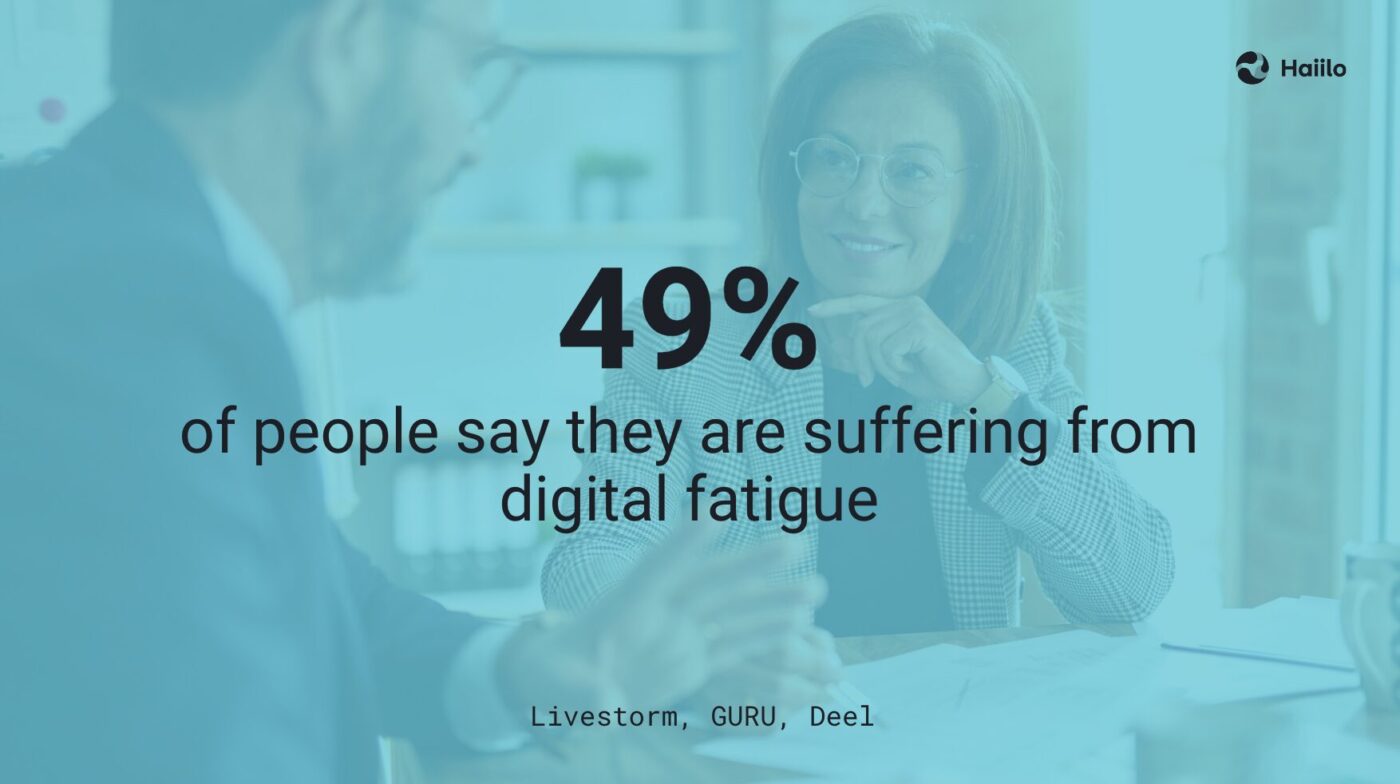Digital fatigue is a challenge many employers and their employees face worldwide. Since the introduction of remote and hybrid work, this trend has been on the rise and organizations have been looking for ways to fight it.
In one survey, a whopping 49% of respondents declared they suffered from digital fatigue.

So in this blog, we will define digital fatigue, explain its negative impact on business success, and share ways to properly manage it in the workplace.
What Is Digital Fatigue?
Digital fatigue, also known as zoom fatigue or technology fatigue, is a form of mental exhaustion that comes as a consequence of extensive exposure to screens. Many who suffer from digital fatigue feel that they have no separation between work and free time, and they experience low motivation and morale.
According to research, globally, people average 6 hours and 58 minutes of screen time per day . Daily screen time has increased by nearly 50 minutes per day since 2013, and the average American spends 7 hours and 4 minutes looking at a screen each day.

This is not surprising as people use digital platforms to communicate with their peers, friends, family, and coworkers daily.
According to research by Deloitte,
For many people, devices are essential to how they socialize and communicate. In fact, 40% of our survey respondents said they interact more with people through their devices than in the physical world—and that’s true for over half of Gen Zs and nearly half of Millennials.
4 Ways Digital Fatigue Impacts Your Business and Employees
Proper workplace communications and healthy employee connections are critical for overall business success , but with the rise of digital tools in the workplace, digital fatigue can easily set in.
According to research, digital fatigue can see decreased productivity and, ultimately, higher turnover rates Another study found that digital fatigue can lead to a lack of physical activity among employees, resulting in poor employee well-being and poor employee experience.
1. Productivity
One of the biggest downsides of digital fatigue is cognitive overload. Constant app-switching requires employees to quickly adapt to new contexts which often leads to lower employee productivity.
On average, modern organizations use close to 300 cloud applications.
Navigating between dozens of different workplace apps can significantly disrupt workflow continuity, and the search for information becomes quite challenging and inefficient.
Consequently, employees’ attention span decreases, decision-making becomes challenging, frustrations and mental fatigue increase, and overall performance drops.
2. Wellbeing
Previously mentioned research found that 39% of people worry that their device usage may negatively affect their physical well-being, and one-third were concerned that their device usage may negatively affect their emotional well-being, leading to anxiety or depression.

In fact, there is a clear link between screen time struggles and well-being concerns – six in 10 of those who feel they spend too much time on screens worry about the effects on their physical and emotional well-being, while just two in 10 of those who say they don’t struggle with screen time express the same worries.
📚Related: What Is Employee Wellbeing and How to Launch a Wellbeing Program
3. Security
New research from CybSafe discovered that digital overload and multiple communication channels can also lead to a decline in engagement with cybersecurity training.
The research showed that 54% of today’s office workers are ignoring important cybersecurity alerts due to information overload, and 47% admitted that information overload is having an impact on their ability to identify threats such as suspicious emails.
With 72% confirming they feel at least occasionally overwhelmed with the amount of information and communications they get at work, it’s little wonder cybersecurity engagement is being impacted as a result.
4. Communication and collaboration
Most organizations use multiple communication channels, such as intranets, emails, instant messaging platforms, project management tools, and video conferencing apps to communicate daily.
While all these tools are necessary, poor multichannel communication strategy is often one of the major causes of digital fatigue and poor workplace communication and collaboration.
More and more, important messages get buried in overflowing inboxes, employees miss important information, and struggle to communicate efficiently.
Decrease digital fatigue with better workplace communications!
6 Ways to Manage Digital Fatigue In the Workplace
According to the previously mentioned research, nearly 60% of respondents said that they feel their employer understands the impact digital fatigue can have on their productivity. While many organizations are aware of the situation, they are yet to act on this increasing trend and better understand how to reduce digital fatigue in their workplaces.
The very first step towards eliminating digital fatigue is focusing on a better digital experience in the workplace.
Same as consumers, employees want experiences that are approachable, interactive, engaging, personalized, genuinely helpful, and authentically human.
So while digital tools in the workplace are necessary and cutting screen time may not be possible, there are ways to improve DX in your organization!
Let’s take a deep dive.
1. Make their digital experience interactive
Today, employees expect an interactive digital experience and they want to participate actively in it. Internal communications professionals play a big role in creating such experiences and they need to understand that employees are likely to tune out if they just need to sit and read or watch something.
Modern IC and HR professionals understand that the best virtual events, internal podcasts, webinars, and content experiences put the audience at the center of the experience, allowing them to engage.
Many of them are, therefore, looking for modern social intranets with polls, Q&As, chat, surveys, and various gamification functionalities.
This way, they are not just watching an experience; they are participating in it.
2. Leverage AI to streamline information search
As mentioned earlier, extensive information search is one of the biggest causes of digital fatigue.
Some advanced workplace solutions have recognized the power of artificial intelligence in streamlining the search for information and making it much more efficient.
For example, Haiilo’s social intranet leverages generative AI to make information search seamless for employees. When employees have a specific work-related question, they get an answer instead of a list of different links and resources to work with. Think Google Search versus ChatGPT.
This is a game-changer in the world of information overload which is one of the biggest productivity killers for employees and organizations across the globe.
📹 Take a look at how Haiilo leverages AI to enable employees to find information at scale (among other things 😉)
3. Focus on segmentation and personalization
Too much of internal communications tend to be high-level, generic content delivered to the entire employee database.
But today, employees are looking for content that speaks to their unique needs and is relevant to their job functions, locations, interests, and other criteria.
According to research, around 50% of communication and HR professionals say that their technology doesn’t allow them to serve content based on employees’ interests, and targeting based on engagement is even lower.
Luckily, modern intranet solutions offer different segmentation criteria which allows comms professionals to curate and publish content in one place and make it highly relevant through dynamic audience targeting.
The more personalized the experience is, the more employees tend to engage and the less they experience digital fatigue.
4. Integrate your tech stack
Accessing and reaching people, information, tools, and documents from a single platform can significantly reduce digital fatigue and decrease the overall perception of app-switching.
This is why integrated workplace tech is so important.
Rather than simply relying on cloud-based ecosystems such as Google Workspace and Microsoft 365, the most successful teams implement an integrated digital workflow system. This approach simplifies and streamlines workflows by leveraging data from existing systems and creating automated processes to eliminate manual, time-consuming tasks.
As nicely put in an article by leadership professor Benjamin Laker:
Integrated digital workflow systems promote collaboration by centralizing data and information, eliminating the advent of shadow IT, which can cause significant problems for organizations. By consolidating all relevant data into a single source of truth, users are able to access the most up-to-date version of any document or file, enabling a much-needed single view of work progress.
5. Build employee communities and meaningful connections
Employers that understand the causes and consequences of digital fatigue also know that making employees more connected is important.
But, instead of adding new communication tools and channels to the organization, employers need to focus on building more meaningful connections and engaging employee communities which we define as:
… a virtual social-media-like place where employees come together to connect, communicate, and collaborate with each other. It serves as a single hub for employees to access information, share knowledge, ask questions, provide feedback, find documents, and collaborate with peers. It streamlines internal communications, strengthens relationships between employees, and provides quick access to the resources they need. Simply put, the employee community is a digital home for your workforce.
And the very first prerequisite for implementing a healthy employee community is the right technology. Social intranets are the most commonly used tools for building, managing, and nurturing online communities in the workplace.
6. Create more internal awareness and ask employees for help
One of the best ways to manage digital fatigue in your workplace is to create more internal awareness about it.
Many people who actually experience digital fatigue may not be aware of this phenomenon.
So consider implementing a monthly employee newsletter or an internal company podcast devoted to this topic. You can ask employees to share their own experiences, concerns, learnings, and suggestions.
If you are thinking about new intranet content ideas, this topic may be interesting to your workforce, especially if you are operating in remote or hybrid work environments.
Last but not least, ask your employees for feedback and help!
The best way to understand the causes and downsides of digital fatigue and figure out ways to fight it is by asking your employees directly.
The best and easiest way to do so is by distributing simple employee surveys. To help you get started, here is a suggestion for 3 questions you can ask in your first survey:
How strongly do you agree with the following statements (1 being strongly disagree, 5 being strongly agree):
- I have been experiencing digital fatigue in the workplace
- I feel that digital fatigue is taking a toll on my job performance
- I think my organization takes appropriate initiatives to reduce digital fatigue among employees
- I think there are ways to reduce/eliminate digital fatigue. Please specify how.










